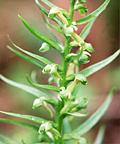Coeloglossum viride (L.) Hartm. var. virescens (Muhl.)
Luer
Green-bracted orchid, long-bracted orchid, frog orchid
Coeloglossum is a monotypic genus with a palearctic distribution.
The generic name is derived from the Greek koilos glossum meaning
"hollow tongue," undoubtedly referring to the hollow spur on the
tongue-like labellum. The specific epithet viride and the varietal
epithet virescens are both taken from the Latin meaning "green,"
in reference to the green color of the flowers.


DESCRIPTION: Plant
arising from a palmate tuber, 10-55 cm high. Leaves 2-6, obovate
to elliptical, becoming lanceolate higher up on the stem, 5-14 cm long and
2-7 cm wide. Inflorescence a loose or dense raceme, 7-70 flowered;
flowers subtended by conspicuous lance-linear, acuminate bracts, 1-6 cm
long, the lower bracts longer and typically greatly exceeding the length
of the ovary and pedicel. Sepals ovate-elliptic to ovate, 3-7 mm
long and 2-4 mm wide, dark green; sepals connivent with petals to form a
hood over the column, opposite the labellum. Petals lance-linear,
3.5-5 mm long and about 0.5 mm wide, closely appressed to the dorsal and
lateral sepals and colored as the sepals. Labellum strap-shaped,
typically with the apex split to form two tooth-like divisions (and often
a third smaller tooth between them), 5-11 mm long and 1-4 mm wide; labellum
with a saccate (2-3 mm long) nectar spur projecting behind.
SIMILAR SPECIES: This species is often confused with Platanthera
flava var. herbiola, particularly when dried and mounted
as an herbarium specimen. Coeloglossum can be distinguished most
effectively by its labellum, which is notched at the tip and lack the prominent
tubercle of P. flava var. herbiola.
HABITAT: Coeloglossum is typically found growing in moist, rich
deciduous woods, frequently on steep slopes.
FLOWERING DATES: May 20-July 15.
POLLINATION: Catling (1983)
reports that Coeloglossum is autogamous via incoherent pollinia. That is,
the pollinia crumble and some pollen falls on the stigma, fertilizing the
flower. In Europe, it is reported to be pollinated by beetles and small
wasps.
WI DISTRIBUTION:  U.S. DISTRIBUTION:
U.S. DISTRIBUTION:
Go directly to Wisconsin herbarium
records.
Return to the main LIST of
the Orchids of Wisconsin.
Return to the main KEY to the Orchids of
Wisconsin.


 U.S. DISTRIBUTION:
U.S. DISTRIBUTION: